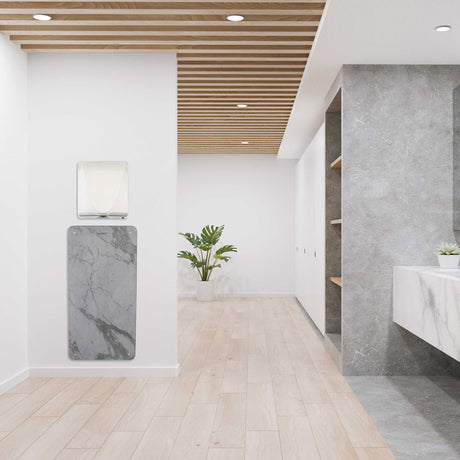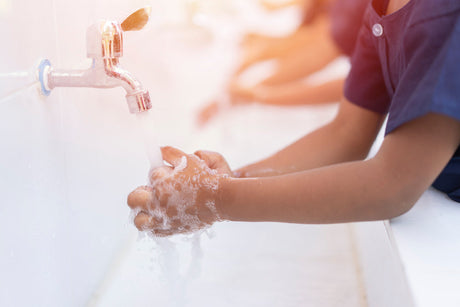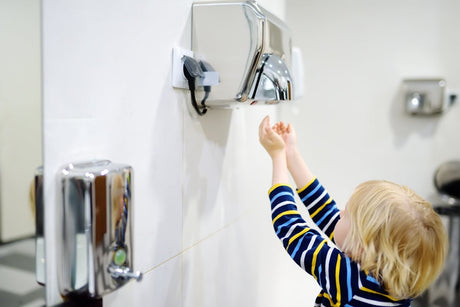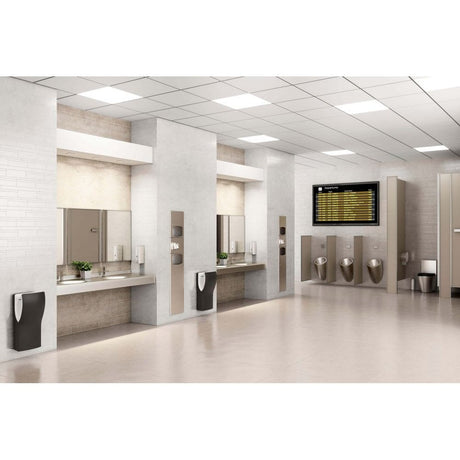The Dyson Airblade is an electrically powered hand dryer manufactured in Malaysia by the Whiltshire based, UK company Dyson. Dyson were originally famous for inventing the bagless vacuum cleaner and for changing the way that vacuums move by introducing a ball rather than wheels to give a greater range of movement. This idea came from one of James Dyson’s earlier inventions, the Ballbarrow which made wheelbarrows easier to maneuver.
The Dyson Airblade used the patented vacuum motor technology and HEPA filtration to revolutionise the electric hand dryer market. While they weren’t the first company to invent to dual airflow, hands in’ technology’, that honour goes to Mitsubishi in Japan in 1993, they were the first to popularise this design throughout the world.
What was different about the Dyson Airblade?
Instead of the single jet or multiple jet technology used on recent innovations like the Xlerator or Airforce hand dryers, the original Dyson Airblade uses a thin sheet of unheated air travelling at around 400 mph and hitting the hands from both sides to strip water from the hands and into a water drainage tank. Subsequent Airblade models have removed the tank feature and as such there is debate that this design will eventually be removed from the range as the Dyson tap and dryer gains more recognition for its practicality.
Although this technology was not unique, the speed of the airflow was a big leap at the time and changed the face of the market. Dyson can largely be credited with the huge glbal demand for energy efficient, high speed hand dryers we have today. The impact this has had on landfill waste and associated carbon emissions deserves huge credit.
Conventional electric hand dryers had largely relied on evaporation to dry the hands.
The history
2006 – The first
The original Dyson Airblade AB01 was launched in the UK in 2006 and the US in 2007. The appearance is pretty much the same as the current model, however the original had a drainage tank and a lacquered steel finish, both of which proved to be problematic and were changed in later models. the lacquered finish frequently came off over time, exposing the raw material. The Ab03 which was also released in 2006 had a polycarbonate body as this is the material that has continued to be used in later models.
2013 – A range of designs
Three new models of the Dyson Airblade were launched, The Airblade mark 2 which had an increased jet speed of 430 mph from the previous 400 mph without the noise output increasing.
The Dyson Airblade V (AB08/12) was their first ‘hands under’ offering, bringing angled, blade innovation and a super speed motor to compact models. The Dyson V was just 10 cm deep and therefore complying with legislation for US disabled toilets.
The Airblade Tap (AB09, AB10, AB11) which is a sensor tap and hand dryer, often referred to as the Wash and Dry system, was truly unique in that the hands could now be dried directly over the sinks, overcoming the age-old problem of wet floors. All three hand dryers use a new Digital Slim Motor, the Dyson V4.
2016 – The current Dyson Airblade AB14 was introduced, further utilising noise reduction technology in response to an issue that was becoming increasingly important for customers. The product received the Quiet Mark. The decibel level at 1 metre was reduced from 85 dB(A) to 80 dB(A). An effective 50% reduction.
2017 – The second-generation Dyson V was launched, continuing the trend of noise reduction. The Hu02 was again 50% quieter at 80 dB(A), however unlike the ab14 this caused a 2 second reduction in dry speed from 10 to 12 seconds.
Controversy
The impact The Dyson Airblade has had on the paper towel industry has been huge, cutting off large revenue streams in public facilities across the world, as such there has been a concerted PR smear campaign targeting the Airblade. The battle going on within the industry has been encapsulated very well in the Guardians long read. The paper towel industry has continuously raised concerns about the hygiene of Dyson Airblades, despite the product bring approved by HACCP for safety within the food production industry and the NSF for hygiene.
Dyson has responded to the unhygienic claims but the PR machine continues to roll on.
In December 2012, Excel Dryer, the producers of the Xlerator filed a lawsuit against Dyson, claiming that Dyson's advertising comparing the Airblade to the Excel Dryer XLerator were deceptive. Dyson produced national advertisments in the US stating the XLerator produced twice as much carbon dioxide, were not as good for the environment, and running costs were far higher. Excel Dryer claimed that Dyson was the falsifying basis the comparisons by stating a 20-second dry time for the XLerator, rather than their own 12-second dry tested time.
What’s next?
There are rumours circulating Dyson have recently dropped hints that they are about to release a new Airblade model. Speculation that it will use the silent technology from their supersonic hair dryers abound...
To view the current Dyson Airblde models including the taps, ab14 and HU02. click on the link.




